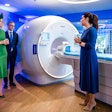
By Peter Staff
The filmless radiology department is no longer confined to the dreams of visionaries; it has long been accepted that digital technology is the way forward. We have seen a wholesale reduction in paper documentation in many areas of our lives, and it is technically possible -- although commercially and politically fraught with obstacles -- to envision a paperless hospital in the foreseeable future. For medical imaging companies, the integrated healthcare environment remains the Holy Grail.
The demise of silver-based film imaging has been predicted since at least 1979, when then-billionaire Bunker Hunt and other speculators succeeded in engineering a dramatic upward spiral in silver prices. Many believed that x-ray film would soon be replaced with a better, cheaper, and perhaps more sensitive medium. After all, x-ray film not only has a "use by" date -- after which its base fog level slowly starts to rise -- but due to the variety of types and sizes that are used, its use is a logistical nightmare for manufacturers, suppliers, and consumers alike.
Computed radiography
Computed radiography (CR) was initially brought to market by the Fuji Photo Film Company of Japan in the 1970s. Its CR system, then known as FIDECS, was first shown at the 1981 International Congress of Radiology in Brussels, Belgium. CR took advantage of the fact that some phosphors, when coated onto a photostimulable imaging plate and excited by an x-ray exposure, have the ability to store images for up to six hours.
If the plate is then put into a scanner, where a helium neon laser scans it, light is emitted and captured by a photomultiplier tube. The tube converts the data into an analog signal, which is then digitized and sent to a computer. The computer then processes the data and displays it in the form of an image.
In practice, CR plates are available in the same sizes as x-ray film and are housed in a cassette (similar to a conventional film-screen cassette) while the x-ray exposure is made. The exposed cassette is taken by the radiographer to a CR reader, which generally serves a number of x-ray rooms, to allow the plate to be scanned and erased so that it can be used again. These plates can be used many times before they need replacing.
Scandinavia and the U.K. were the pioneers of CR in Europe, and they are still fertile markets for those medical imaging companies offering CR systems. Finland, for example, has CR installed in 80%-90% of all of its x-ray rooms (250-300 rooms). Italy and France now have caught up, with huge numbers of CR systems being installed. CR in France has benefited from government legislation setting re-imbursement for CR examinations at a rate higher than that for conventional exams.
It is estimated that up to 80% of the 3,500 private radiology clinics (known as cabinets de radiologie) have CR units from Fuji Medical Systems, Agfa HealthCare, Eastman Kodak Health Imaging,and Philips Medical Systems (a branded Fuji CR system with a different workstation). Approximately 70% of the 700 French hospital x-ray departments are currently using CR, and this number is increasing at the rate of 30 installations per year. In the French dental x-ray field, about 10% of the 30,000 dentists are using CR -- with most of them being supplied by Gendex of Des Plaines, IL.
Direct radiography
Work started on direct radiography (DR) in the early 1990s, with several technical papers being published in 1995 and 1996 on this new technology. Initial systems developed by the Du Pont Corporation of Wilmington, DE, were installed for evaluation purposes in two sites in the U.K.: the Royal Victoria Hospital in Newcastle and Addenbrookes Hospital in Cambridge. Addenbrookes Hospital is still using the original system, along with new equipment from Canon Medical Systems and Siemens Medical Solutions that was installed within the past year.
Finland now has between 20 and 25 DR installations, a figure that is increasing as replacement units for film-based systems are required. Sweden, Denmark, and Norway also have a number of complete DR x-ray rooms installed in many major imaging centers -- with the reason for purchase being given as the benefits gained by DR’s far superior speed and patient throughput. France is a huge market for dental x-ray systems using DR technology from vendors such as Trophy (Marne-La-Vallée Cedex 2, France) and Instrumentarium Imaging.
DR can use either a flat-plate digital detector -- featuring a semiconductor material such as amorphous selenium or amorphous silicon -- or utilize a structure comprising an array of charge-coupled devices (CCDs). Flat-panel detectors can either be direct or indirect capture, although from the user’s point of view, it makes no difference to the way the examination is carried out.
In both direct and indirect systems, an electric charge pattern is created by the x-ray exposure, sensed by an electronic readout mechanism, and then converted from analog to digital. As in CR, a computer then processes the data and displays it in the form of an image.
CR versus DR
Both systems have the advantage of using digital technology and the capability to manipulate and enhance images, which virtually eliminates the need for retakes. Images are rarely lost, and they don’t need to be manually filed.
Digital images, when stored and retrieved on a PACS, can be viewed simultaneously by two or more clinicians in different and remote locations, allowing the discussion of a patient’s images or their inclusion in a multidisciplinary meeting. Algorithms built into the system software allow manipulation and enhancement of images to show diagnostic information that would previously be impossible to display on an x-ray film.
After nearly 20 years, CR must be considered a mature technology, used throughout the world with many thousands of systems in use every day:
- CR is portable, with the cassettes that house the plates being very familiar in weight, size, and shape to radiographers.
- CR is currently cheaper than DR to purchase.
- Until recently most DR systems required you to purchase a complete system, which is not the case with CR.
- A number of x-ray rooms can share a CR reader.
DR is considered to be the technology of the future, inasmuch as it is much faster and easier to use than CR, and requires no plate/cassette handling by the radiographer:
- Certain DR systems allow an image to be viewed within 2 seconds of the x-ray exposure being made. In several U.K. hospitals, DR has allowed general-purpose x-ray rooms to be closed down or used for other purposes. Vendors have used the tremendous shortage of radiographic technicians in the U.K. as a motivator for facilities to migrate to DR.
- DR has no moving parts and does not need a budget line item for replacement plates, as does CR. This has to be taken into account when calculating whole-life costs.
- Some manufacturers’ flat-plate detectors can be retrofitted into existing x-ray equipment, thereby eliminating the need to replace perfectly serviceable units.
- Portable flat-plate detectors are now available that allow radiography to be carried out at a patient’s bedside (without the need to carry a supply of heavy cassettes or return to a CR reader to have the CR plates scanned and the resultant images viewed). I also understand that a digital mobile x-ray machine will be launched in the near future that will allow exposures to be made anywhere within a hospital, and that multiple images can be stored on the unit or downloaded to the hospital’s PACS.
- DR system prices are already dropping and will continue to do so, as one would expect from a computer-based system where manufacturing volumes are steadily rising.
- Manual handling regulations throughout the European Union mean that DR is favored, as it obviates the need to carry cassettes to and from a CR reader.
- The DR image on a diagnostic-quality CRT or TFT flat-screen monitor looks to most radiologists more like conventional x-ray film than a CR image.
- The x-ray dose required by DR is similar to that given for a film-screen exposure, whereas CR sometimes requires approximately twice the dose.
- Most DR systems appear to be extremely reliable.
Research carried out in several hospitals and a university in the U.K. has shown DR to be between 2.5 and 4 times faster than CR. A study conducted by a radiography tutor and students from the School of Radiography at Cranfield University found that DR and CR examinations at the Bristol Royal Infirmary and the Princess Margaret Hospital Swindon could be even faster. They concluded that should the DR systems be connected to a PACS and patient demographics be automatically downloaded onto the DR worklist to populate the DICOM header, then this advantage would probably rise further.
Hospital PACS networks, whether enterprise-wide or miniPACS, are being installed at an ever-increasing rate in Europe. In the U.K. there is a drive by the British government to introduce electronic patient records (EPR), and digital acquisition systems such as CR and DR are an integral part of this initiative. Large sums of money have been promised to fund several innovative (and some might say daring ) new schemes to roll out information technology throughout the National Health Service and provide clinical images to locations throughout the healthcare community.
New advances in digital acquisition systems, such as CR and DR, are continually pushing traditional boundaries, causing some people to view their inevitable introduction with some skepticism. The world may be well and truly in the computer age, but there is still the need to overcome considerable inertia. Clinicians, who have examined x-rays on viewboxes for 40 years, must be encouraged to look at them on a monitor and not to hold them up to a window (known by cynics in the U.K. as "God’s Viewbox"). This is where all the skills and native cunning of change-management specialists are required.
However, the considerable improvement in service times that digital technology brings to imaging departments in Europe can offset several critical problems facing radiology: the shortage of qualified radiologists and radiographers in the U.K.; the year-on-year increase in the number of x-ray examinations that are requested by referring clinicians; and the continued rise in patient expectations.
By Peter StaffAuntMinnie.com contributing writer
November 28, 2002
Peter Staff is managing director of Xograph Imaging Systems, a privately owned medical imaging company in the U.K. He has more than 30 years experience in the radiology industry. Staff is also a member of the U.K. Parliament’s Associate Parliamentary Health Forum, and sits on the British Institute of Radiology’s Industry Committee.
Related Reading
The parlous state of UK radiology, September 24, 2002
Do private imaging centers have a future in the U.K.? August 15, 2002
Radiology service not keeping up with routine demand in UK, August 8, 2002
UK's imaging demands exceed capacity of personnel, September 12, 2001
U.K. radiologists grapple with privacy act, August 13, 2001
Copyright © 2002 AuntMinnie.com



















